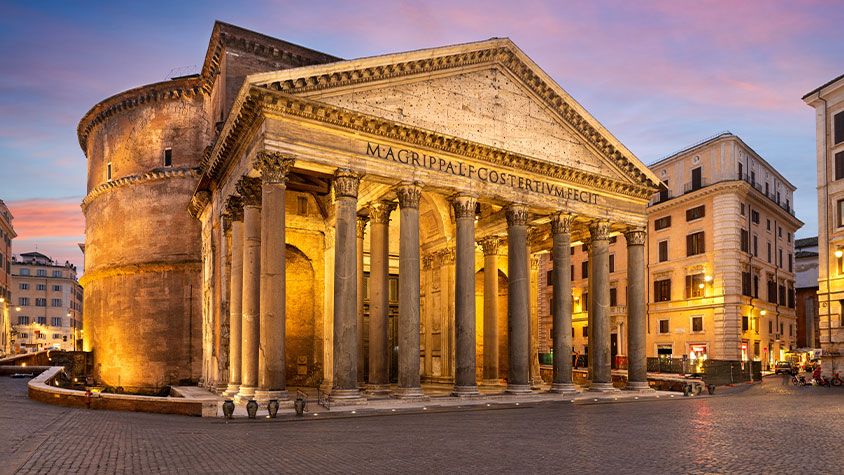If one had to finish the oft-quoted sentence, “When in Rome…” with only one directive, it should be “When in Rome…visit the Pantheon.” That’s because this ancient edifice is not just a 1,900-year-old architectural marvel; it may just be the architectural marvel of all time.
Perhaps the most well-preserved ancient structure anywhere on earth, the Pantheon offers an awe-inspiring window into the 2,000-year story of Rome. While the name, Pantheon, literally means “all gods” in Greek, many historians doubt that the worship of multiple ancient deities ever came into play there. Rather, it was the beauty of the heavens above as seen through the Pantheon’s giant hole, or circular oculus (“eye” in Latin) situated atop its celestial-like dome, that made “Pantheonites” feel the touch of the divine.
Emblazoned across the front of the Pantheon are the words, M·AGRIPPA·L·F·COS·TERTIVM·FECIT, which in today’s vernacular, simply means: “M. Agrippa made it.” Roman Consul Marcus Agrippa commissioned the structure in 27 BC, though it was rebuilt around AD 126 by the emperor Hadrian after the original structure burned down. Hadrian kept the original inscription by Agrippa, which is why the age of the edifice is a historical fact rather than a conjecture.
In AD 609., the Pantheon was turned into a church at the order of Pope Boniface IV. While much of its original illustriousness was erased during the building’s conversion, that switch providentially proved to be the structure’s salvation. Because of its continuous use, the Pantheon managed to escape the fate of other ancient buildings over the centuries. The Pantheon’s status as a church meant that the edifice did not suffer from the ravages of time and avarice, with the notable exception of its original bronze ceiling.
As is sometimes the case, superstition supersedes science as it did during medieval times. Some believed that upon the eve of the conversion of the Pantheon to a church, a horde of demons who had infested the structure from its inception were forced to flee by bashing a hole through the dome as they beat a hasty retreat from the newly christened house of God. In reality, the famous 27-ft. circular oculus located at the apex of the Pantheon’s dome actually helped in lightening the load of the massive dome, as well as the entire building (not to mention allow for spectacular shafts of light to flow down into the edifice), a feat of structural engineering clearly not understood during medieval times.
Besides containing numerous religious symbols, the Pantheon is also the burial place of kings and artists, the most notable being the Prince of Painters, Raphael, who was buried there in 1520 at the age of 37. Visitors can take in these experiences as well as the releasing of rose petals every May on the Christian feast of Pentecost. A highly popular event (pilgrims arrive at the crack of dawn), the ritual is intended to symbolize the descent of the Holy Spirit onto Christ’s apostles after His death.
The Pantheon, perhaps the most spectacular miracle in terms of structural engineering, also offers a rich history—both pagan and religious—upon which to both reflect and contrast to our own modern-day lives. As for visiting the rest of Rome—besides architecture, art, and numerous pilgrimage sites such as the Mamertime Prison, where the incarcerated apostle Paul penned the words, “I have fought the good fight of faith”—there is always food and fashion; two things that one can never get enough of in Rome specifically, or Italy in general.
Visit one of the world’s most well-preserved architectural marvels that reflects the engineering genius of the ancient Romans while displaying the intriguing intersection of science, superstition, and faith.
Email Cindy at cindy@israeladvantagetours.com and
visit www.israeladvantagetours.com to make your trip of a lifetime a reality!















